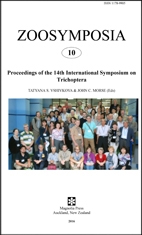Abstract
We investigated the abundance of adult caddisflies in the precincts of food and pharmaceutical factories. The objective of this study is to clarify the abundance of adult caddisflies from the cooling tower and catch basin by a light trap in the vicinity of food and pharmaceutical factories. In addition, to clarify the role of vegetation near factories for adult caddisflies, an investigation of the number of insects using vegetation was conducted with light traps. The light traps were operated in mid May−early June, end July−mid August, and mid−end October 2009. At St. 1, the highest number of hydroptilid adults was collected in cherry trees (64 individuals), followed by the cooling tower (38 individuals), and the catch basin (only one individual). On the other hand, the highest number of hydroptilid adults at St. 2 was collected in the catch basin (15 individuals), followed by cherry trees (7 individuals), and cooling tower (6 individuals). No hydroptilid adults were collected in the cooling tower and vegetation at St. 3. These results suggest that factories may be exposed to periodic invasions of adults from not only natural aquatic ecosystems, rivers and lakes, but also small man-made aquatic ecosystems, cooling towers and catch basins, in the vicinity of factories.
References
Ali, A. (1995) Nuisance, economic impact, and possibilities for control. In: Armitage, P. D., Cranston, P.S. & Pir1der, L.C.V. (Eds), The Chironomidae: Biology and Ecology of Non-biting Midges, Chapman & Hall, London, pp. 339−364.
http://dx.doi.org/10.1007/978-94-011-0715-0_13Botosaneanu, L. (1970) Trichoptères de la République Démocratique-Populaire de la Corée. Annales Zoologici, 27 (15), 275–359.
Corbet, P.S. (1966) A quantitative method for assessing the nuisance caused by non-biting aquatic insects. The Canadian Entomologist, 98, 683–687.
http://dx.doi.org/10.4039/Ent98683-7Fredeen, F.J.H. (1972) The temporary abatement of nuisance species of Trichoptera with DDD (TDE) larvicide. The Canadian Entomologist, 104, 145–163.
http://dx.doi.org/10.4039/Ent104145-2Gorham, J.R. (1978) Training manual for analytical entomology in the food industry. FDA Technical Bulletin No. 2. HHS Publication No. (FDA) 77-2086. U.S. Food and Drug Administration, Washington D.C., 174 pp.
Hata, K. & Kurihara, T. (1982) Mosquito larvae found in catch-basins in an urban area. Japanese Journal of Sanitary Zoology, 33, 247–248. [in Japanese with English summary]
Hirabayashi, K. & Watanabe, S. (1996) Massive flights of chironomid midges (Diptera) found on the shoreline of Lake Kawaguchi, Japan during the spring season. Medical Entomology and Zoology, 47, 223–230.
Imai, C. (2004) Possible outbreak of and mearures against West Nile Virus in Japan. Seikatsu Eisei, 48, 341–352. [in Japanese with English abstract]
Japan Meteorological Agency (2006) Weather, Climate & Earthquake Information. Available from: http://www.jma.go.jp (accessed 29 January 2013) [in Japanese]
Kimura, G., Inoue, E. & Hirabayashi, K. (2011) The effect of a summer flood on the density of caddisfly (Trichoptera) in the middle reaches of the Shinano River, Japan. Zoosymposia, 5, 235–244.
Mackay, R.J. & Wiggins, G.B. (1979) Ecological diversity in Trichoptera. Annual Review of Entomology, 24, 185–208.
http://dx.doi.org/10.1146/annurev.en.24.010179.001153Martynov, A.V. (1935) Trichoptera of the Amur Region. Part I. Travaux de l'Institut Zoologique de'l Académie des Sciences de l'URSS, Leningrad, 2, 205–395 [in Russian and English]
Mitsui, E. (1990) Food Industry and Insect Pests. Insects as Food Contamination. Korin, Tokyo, 244 pp. [in Japanese]
Mori, S. & Matsutani, K. (1953) Daily swarmings of some caddisfly adults and their habitat segregations. Japanese Journal of Zoology, 62, 191–198. [in Japanese with English resume]
Munroe, E.G. (1951) Pest Trichoptera at Fort Erie, Ontario. The Canadian Entomologist, 83, 69–72.
http://dx.doi.org/10.4039/Ent8369-3Nakano, K. (2009) Insect fauna collected by sticky trap in underground drains. Pestology, 24, 65–69. [in Japanese]
Ogata, K. & Kouraku, A. (2000) New Technique for Control of Food Contamination. Fuji Techno System, Tokyo, 384 pp. [in Japanese]
Osgood, H. (1957) Allergy to caddis fly (Trichoptera). I. The Journal of Allergy, 28, 113–123.
http://dx.doi.org/10.1016/0021-8707(57)90017-5Peterson, D.G. (1952) Observations on the biology and control of pest Trichoptera at Fort Erie, Ontario. The Canadian Entomologist, 84, 103–107.
http://dx.doi.org/10.4039/Ent84103-4Sibasaki, I. (1999) Hygiene Management of Pest. Fuji Techno System, Tokyo, 704 pp. [in Japanese]
Tanida, K., Nozaki, T., Ito, T. & Hattori, T. (2005) Trichoptera. In: Kawai, T. & Tanida, K. (Eds.), Aquatic insects of Japan: Manual with keys and illustrations. Tokai University Press, Kanagawa, pp. 397–572. [in Japanese]
Ulmer, G. (1908) Japanische Trichopteren. Deutsche Entomologische Zeitschrift, 1908, 330–355.
http://dx.doi.org/10.1002/mmnd.48019080304Wallace, I. (2003) The Beginner’s Guide to Caddis (Order Trichoptera). Bulletin of the Amateur Entomologists' Society, 62, 15–26.
Waringer, J.A. (1989) The abundance and temporal distribution of caddisflies (Insecta: Trichoptera) caught by light traps on the Austrian Danube from 1986 to 1987. Freshwater Biology, 21, 387–399.
http://dx.doi.org/10.1111/j.1365-2427.1989.tb01371.xWatanabe N.C., Mori, I. & Yoshitaka, I. (1999) Effect of water temperature on the mass emergence of the mayfly, Ephoron shigae, in a Japanese river (Ephemeroptera: Polymitarcyidae). Freshwater Biology, 41, 537–541.
http://dx.doi.org/10.1046/j.1365-2427.1999.00398.xYagi, M. & Sasakawa, M. (1992) Life history and swarming behavior of caddis fly, Cheumatopsyche brevilineata (Iwata) (Trichoptera: Hydropsychidae). Japanese Journal of Environmental Entomology and Zoology, 4, 1–10. [in Japanese with English abstract]
Zimmerman, M.L. & Friedman, S.L. (2000) Identification of rodent filth exhibits. Journal of Food Science, 65, 1391–1394.
http://dx.doi.org/10.1111/j.1365-2621.2000.tb10618.x

